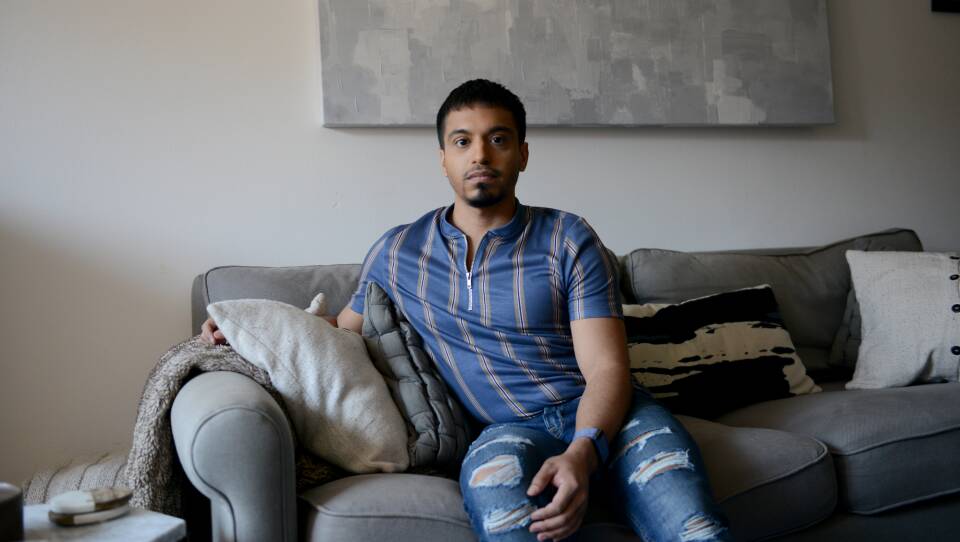Jose Alfaro says he was perfect prey for a sex trafficker because of the color of his skin.
The Mexican American youth was 16 years old and homeless when he reached out for help on the internet more than a decade ago.
He joined a gay chat room and met an older man named Jason Gandy who offered him empathy and a place to stay.
“It seemed like a dream, and at the time, not having anywhere to go,” Alfaro says now.
But the dream quickly became a grim reality. Gandy told Alfaro he would have to work in the older man’s “massage” business, which was a euphemism for prostitution. Alfaro provided sexual massages to Gandy’s clients in his Texas home in transactions that escalated to sexual assault.
Gandy would go on to become the centerpiece of one of the most notorious male sex trafficking cases to be tried in a U.S. federal courtroom. Three of his four documented victims, including Alfaro, were Latino. But at the beginning, Alfaro thought Gandy was just providing a place he could call home.
Many young men have traveled the same path to homelessness and then to sexual exploitation — and young Black and brown men are disproportionately at risk.
“Race plays a major role in human trafficking,” said Alfaro, who is 29 and now works as a hair stylist on Boston’s Newbury Street.

Hundreds of thousands of young people are living without roofs over their heads or surfing from couch to couch in Massachusetts and across the United States, according to a 2017 study by the University of Chicago.
Homelessness leaves youth particularly vulnerable to commercial sexual exploitation — more than a third of homeless youth in a 2016 national study conducted by the federal Administration for Children and Families said they had traded sex for something of value, including money, shelter and food. Researchers spoke to 873 street youth ages 14 to 21 in 11 cities, including Boston, for the study.
More National News
It’s a problem across the gender spectrum. But there’s a growing consensus that too often boys, young men and trans females are not being identified as victims, and a disproportionate number of these missing and runaway youth at risk are Black and brown.
“You have kids that are alone, hopeless, don't have a natural support system, don't have a family, and that makes them at risk to trade sex for food, shelter, love, care,’’ said Lesli Suggs, president of the Boston-based Home for Little Wanderers that works with vulnerable youth.
“You're going to see greater numbers of kids who have experienced sexual exploitation,” Suggs said.
Suggs says a disproportionate number of children in the child welfare system are people of color. In Massachusetts, Black youth are more than 4 times as likely to experience homelessness compared to the overall youth population; Latino youth are nearly three times as likely, according to a 2019 state report .
A simple search for missing boys in Massachusetts on a website run by the National Center for Missing and Exploited Children, reveals mostly Black and brown faces.
‘I figured I had nowhere else to go’
Alfaro’s story started in the small town of Navasota, Texas, about 70 miles northwest of Houston.
His family discovered that he was gay by reading his telephone text messages, he says, and he was presented with an ultimatum: Attend conversion therapy or leave the family home.
Alfaro fled to the home of a friend who said he could stay overnight. From there, he met Gandy on an internet chat room. Gandy offered to pick him up and bring him to his Houston apartment.
“I figured I had nowhere else to go,’’ Alfaro said during a recent interview with GBH News. “What else did I have to lose?”
Alfaro quickly learned he had much to lose. Gandy told him he should earn money in his massage business, and he needed to lie about his age. Gandy took photos of the diminutive, muscular youth without his shirt and posted them on Craigslist. Alfaro says he looked even younger than his age.
The first massage he was shocked to learn he needed to undress — but he felt he had no choice. He was worried about where he could go; he was afraid of being hurt.
“Mentally, I felt trapped,’’ he said. “I felt like there was no way out.”

A Familiar Pattern
Jose Alfaro’s experience is not unique. While definitive data on the country’s sex trade doesn’t exist, a growing number of anti-trafficking advocates say the number of victimized boys and young men is vastly underreported.
A 2016 national study by the New York-based Center for Court Innovation found that more than a third of young people who sold sex for something of value were boys and young men, and 85 percent of the youth were Black and brown. Under federal law any youth under the age of 18 involved in the sex trade is considered a trafficking victim.
Shaplaie Brooks — program director for a Dorchester-based program called BUILD focusing on helping sexually exploited and trafficked males — says she works with many young people who have been kicked out of their homes, finding themselves leaning on predators who push them out on the streets. Most of her clients are youths of color.
But getting male victims of sexual exploitation to come forward, especially in Latino and Black communities, poses a significant challenge, Brooks said. Very few males who work in the sex trade, or survived it, will admit to having been exploited or trafficked. It’s a hard truth, said Brooks, that is clouded by a fear of facing transphobia and homophobia.
And Brooks says young males are often seen as troublemakers, not victims.
“We see them fighting or we see hyper-sexualized behaviors, and that's all that we see,’’ she said.
Harry Regis, a life coach at BUILD, says he knows what to look for — a youth, for example, who is homeless but always responding to a particular person who calls.
“There's so many clues and so many red lights and so many light bulbs that pop up,’’ Regis said. “You start to just pick up on the signs.”
Staff at the Boston-based Bridge Over Troubled Waters, which works with homeless youth, also are looking for signs among youth who either don’t see themselves as victims, or won’t admit what they are up to.
For years, the program has parked its mobile medical van with the familiar blue, green and white logo near places services for homeless youth are most needed -- including Boston Common, Harvard Square, Bay Village and the Fens.
Elisabeth Jackson, executive director of Bridge Over Troubled Waters, said over the years even as human trafficking transactions slithered further underground with the help of the internet, some physical pickup sites for boys and trans youth have barely changed, including clubs, movie theatres and 24-hour eateries. She says too often people see teenage boys as choosing to have sex to survive. Her organization wants to change that. “We see another young person who's being hurt by an adult.”
More than a dozen researchers and advocates interviewed for this series cited implicit bias and systemic racism as factors that portray many boys and young men as criminals rather than as potential victims or survivors of commercial sex exploitation.
In Chicago, biological male youth may make up as much as 58 percent of the the sex trade, according to a regional study . And the vast majority were Black and brown youth, researchers say, selling their bodies in exchange for a roof over their heads and food on their plates.
Lead researcher Laurie Schaffner, a University of Illinois at Chicago professor emeritus, said a lot of the young men were straight but participated in gay sex for money. She said systemic racism resulting in poverty, extreme unemployment and housing discrimination compelled many to trade sex for survival.
“They were telling us there was no way for them to get work,” Schaffner told GBH News. “Some said they were sleeping in parks and a man came up and offered money.”
Joel Filmore says it’s been decades since he was a victim of sex trafficking in Chicago. He is now a therapist with a doctorate. But the 50-year-old bi-racial therapist says the same racism exists today that helped trap him in the system in the 1990s.
Filmore’s father was Black and largely not around. His mother was white, he said, and when she was murdered, he was sent to live with her family, in a home plagued with sexual abuse, incest and racism.
“The color of my skin was the predominant variable in my childhood that led to the abuse — sexual, physical and otherwise,” he said.
The color of my skin was the predominant variable in my childhood that led to the abuse — sexual, physical and otherwise.JOEL FILMORE, A SURVIVOR
When he was 21 he got trapped in the sex trade.
“I got caught up with a sex trafficker, a pimp who forced me out on the streets and got me hooked on crack and heroin,” Filmore said. “You have to consider how I grew up. My family told me I was ugly and that I would never amount to anything.”
After a vicious beating by his pimp, Filmore said it was he who was arrested — one of the dozens of times he was thrown behind bars. “When you're a street person in Chicago, you are treated less than human,” he said.
Filmore says he witnessed a color-coded caste system play out on the streets of Chicago in the world of male sex trafficking, where his lighter skin was an advantage.
“My friends who were also doing the same thing that I was doing, who were dark skinned, were absolutely treated differently than I was,’’ he said. “More harshly.”
More harshly by police, said Filmore. Experts cite homophobia and systemic racism as factors that allow prostituted young men — especially if they’re Black or brown — to be seen as criminals rather than as potential victims.
Filmore says he stole a woman’s purse to feed his crack habit. He was sentenced to three years in prison. After serving about half that, he was released with a new determination to save himself because nobody else was offering to help.
“Any point in time, somebody could have intervened. Just with a kind word, ‘I see you,’’’ he said. “Nobody did that. And I realized I need to be that person.”
Justice for Jose
Jose Alfaro says he ran away from Gandy after a few months following a violent assault by a client. He moved in with another older man and for years lived in a cycle of selling his body to stay alive.
“There were many times where I didn't have food to eat. I didn't have anywhere to go,’’ he said. “I needed to find a way to survive on my own.”
When he was just 21, he moved to Boston with the help of a “sugar daddy,” who paid to support him. He slowly started to emerge from the sex trade after going to school to become a hair stylist. He attended therapy and physical training, and his mind and body began to heal.
In 2014, Alfaro learned from a friend that Gandy had been arrested at the airport in London two years earlier trying to take a 15-year-old boy to the Olympics, his computer filled with child pornography.
Alfaro was first scared — not realizing that he too had been trafficked. He thought he could get in trouble. Eventually he realized he also was a victim. He contacted the National Human Trafficking Hotline, which connected him with Homeland Security Investigations in Boston. “It was the first time that I actually really shared what had happened to me and people were actually willing to listen,’’ he said.

In 2018, Alfaro flew back to Texas to testify at his abuser’s trial. That December, Gandy was convicted on several sex trafficking and exploitation charges and sentenced to 30 years in federal prison.
In a separate civil lawsuit, a judge in 2019 awarded Alfaro more than $1 million dollars in damages from Gandy — about three times the amount he had requested. For the first time, Alfaro felt truly seen. But the memory of being sex trafficked, beginning at the age of 16, is something that he cannot easily shake.
“That wasn't the life that I had planned for myself,” said Alfaro. “And I get so emotional because I had so many dreams, I had so many goals, there were so many things that I wanted to do. I worked so hard at that age. Never in a million years did I think that I'd be a prostitute.”
Today, Alfaro is working on a memoir about his life experience. He is in a stable relationship with the man he loves. He has forgiven his parents though he rarely sees them. He wants others to see how vulnerabilities — whether homosexuality or race or both — can throw people into the hands of traffickers.
“All you have to think about is what communities are more vulnerable to this situation. And you can immediately know where trafficking is happening,’’ he said. “It's people coming from other countries. It's people that are dealing with racism, homophobia. These are the communities that are being impacted the most.”
The reporting for this project began in a Boston University investigative journalism clinic last year. The following students contributed to this series: Samantha Drysdale; Lillian Ilsley-Greene; Diana Leane; Rhian Lowndes; Haley Paraday; Eileen Qiu; Shaun Robinson; Namu Sampath; Sofia Saric; Hao Sun; Xinying Tao; Meredith Varner; Andi Zhang; Zhenhao Zhang











